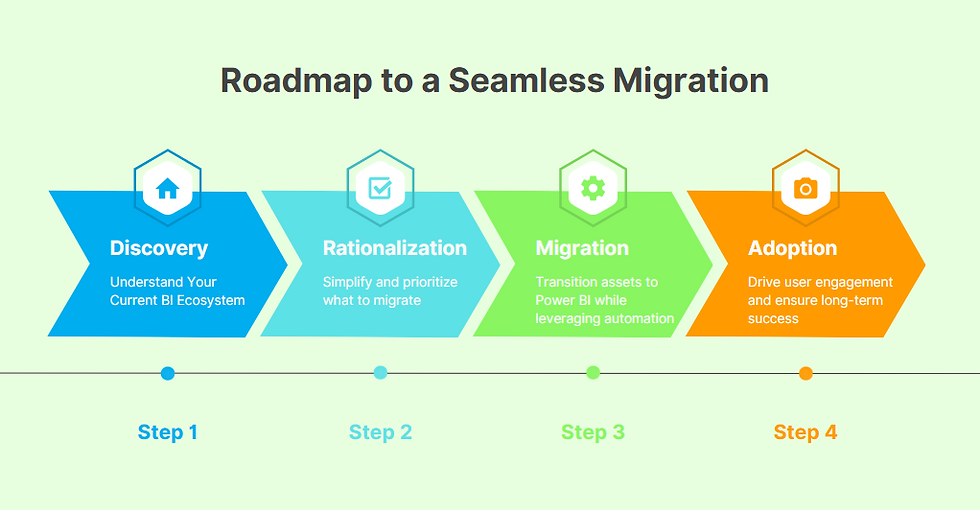Framework for Migration to Power BI: Roadmap to Seamless Transformation
- Microsoft Fabric Guy
- Dec 20, 2024
- 4 min read

Migrating to a modern BI tool like Power BI can seem daunting, especially for large organizations with complex reporting ecosystems. However, with a well-defined framework, the process becomes manageable, efficient, and highly rewarding. Drawing from my experiences with BI migrations for global banks, I’ve developed a structured approach that ensures a smooth transition.
This framework consists of four key phases: Discovery, Rationalization, Migration, and Adoption. Let’s explore each phase and the tools and strategies that can help you succeed.
Lets discuss the framework for Migration to Power BI
Phase 1: Discovery
The first step in any BI migration is to understand the current state of your BI ecosystem. Without a comprehensive understanding of existing assets, processes, and dependencies, migration efforts can lead to inefficiencies and missed opportunities.
Key Activities:
1. Inventory Reports and Dashboards:
Identify all existing BI artifacts, including reports, dashboards, data models, and ETL processes.
Categorize them by usage, business criticality, and complexity.
2. Stakeholder Interviews:
Engage with business users to understand which reports are actively used and which are outdated.
Capture user expectations for the new BI system.
3. Assess Current Infrastructure:
Document data sources, storage systems, and existing BI tool configurations.
Tools and Techniques:
Metadata Analysis Tools: Automate the inventory of reports and dashboards.
User Surveys: Gather insights directly from report consumers.
Phase 2: Rationalization
Not every report or dashboard needs to be migrated. This phase focuses on reducing redundancy and optimizing the assets to be carried forward.
Key Activities:
Eliminate Redundancy: Identify duplicate reports and dashboards and consolidate where possible.
Prioritize High-Value Assets: Focus migration efforts on reports with high business impact.
Simplify Complex Reports: Break down overly complex reports into manageable components.
Tools and Techniques:
Usage Analytics: Identify frequently accessed reports and decommission unused ones.
Collaboration Tools: A tool that can send automated notifications to business to provide decom approval for unused reports and automatically update the report inventory for further follow-ups
Phase 3: Migration
This is the execution phase where reports, data models, and workflows are transitioned to the new BI platform. This is again one of the most important tasks which will decide the success of migration. Although, I have listed few of the activities below, it is essential to onboard a seasoned architect who have performed such migrations. His/her expertise will help design an efficient solution. I will publish a separate blog on how a design of typical migration should look like on fabric.
Key Activities:
1. Data Connectivity:
Set up connections to all data sources in Power BI.
Ensure data governance and security protocols are adhered to.
2. Recreate Reports and Dashboards:
Use Power BI’s robust visualization capabilities to rebuild reports.
Leverage tools to convert calculations and transformations from legacy BI tools to Power BI DAX.
3. Test and Validate:
Perform rigorous testing to ensure accuracy and performance of migrated assets.
4. Automate Wherever Possible:
Use scripts and tools to automate repetitive tasks like report recreation or data transformation.
Tools and Techniques:
ETL Tools: Automate data transformation processes. Use dataflows or even automated semantic models if you are not expecting changes/upgrades to report and security isn't of much concern.
Migration Tools: Convert legacy BI expressions (e.g., Qlik, Tableau) to Power BI DAX.
Phase 4: Adoption
Even the best migration will fail without user adoption. This phase focuses on enabling users to make the most of the new BI environment. I will publish a separate blog on this too which where we will discuss key strategies to increase user adoption.
Key Activities:
1. User Training:
Conduct hands-on training sessions to familiarize users with Power BI features.
Provide resources such as quick-start guides and video tutorials.
2. Monitor Usage:
Track adoption rates and identify areas where users may need additional support.
3. Iterate Based on Feedback:
Continuously improve reports and dashboards based on user input.
Tools and Techniques:
Power BI Usage Analytics: Monitor how users interact with the new system.
Support Channels: Set up a help desk or dedicated Slack channel for user queries.
Insights from Experience
I will publish few detailed blogs on my learnings and how to I overcame challenges. Here are some lessons learned from successful BI migrations.
Involve Stakeholders Early: Early involvement of business users ensures alignment with their needs.
Focus on Quick Wins: Deliver high-impact reports first to demonstrate the value of the new system.
Leverage Automation: Tools like Power Query and Power Automate significantly reduce manual effort.
Ensure Governance: Data governance is critical for maintaining trust in the system.
The Roadmap to a Seamless Migration
Here’s a summary of the framework:
Discovery: Understand your current BI ecosystem.
Rationalization: Simplify and prioritize what to migrate.
Migration: Transition assets to Power BI while leveraging automation.
Adoption: Drive user engagement and ensure long-term success.
Conclusion
A successful BI migration is more than just a technical project—it’s a strategic transformation. By following this framework, you can minimize risks, maximize efficiency, and unlock the full potential of modern BI tools like Power BI.
Are you planning a BI migration? Share your challenges or questions in the comments—I’d love to help you on your journey!




Comments